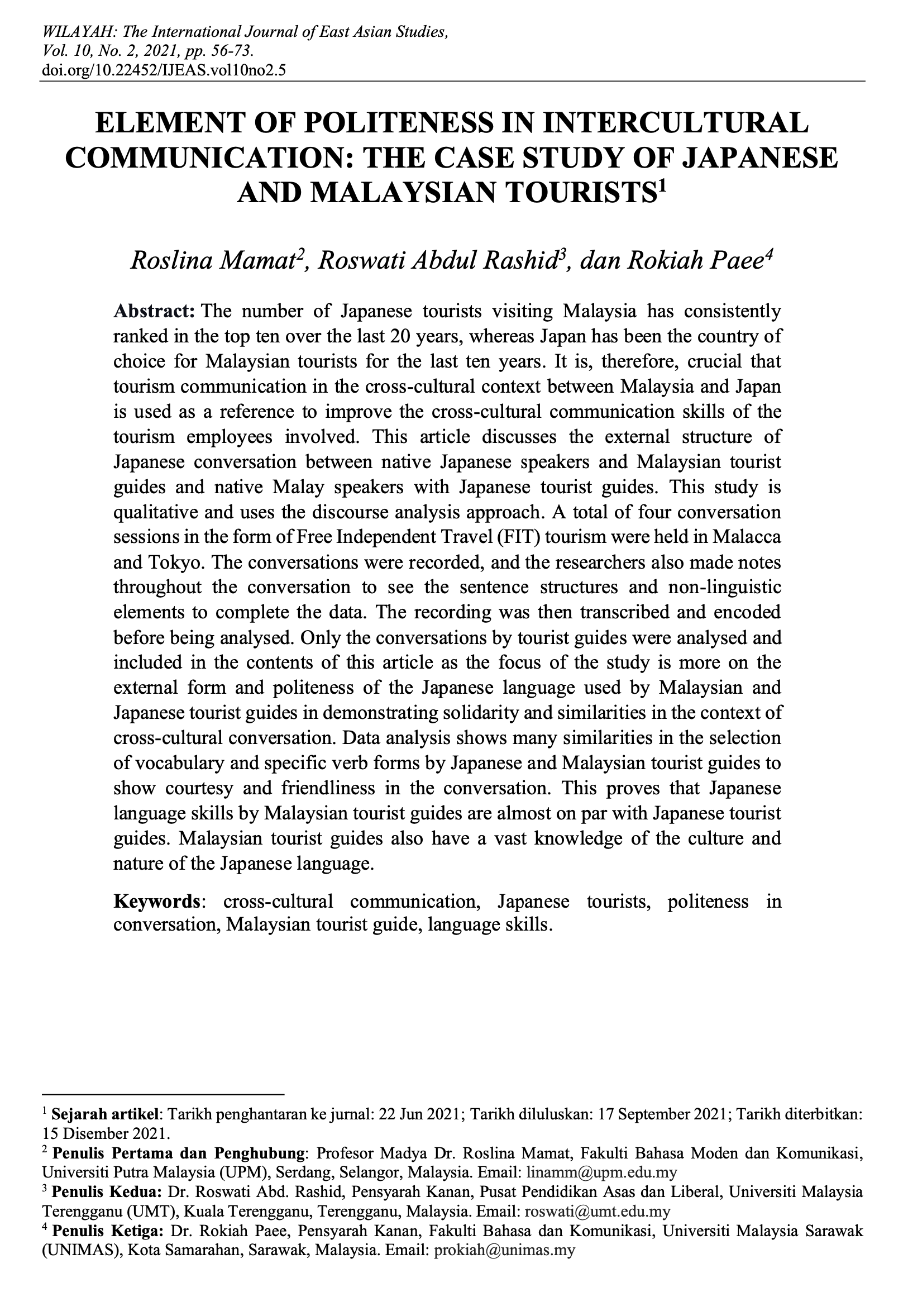Element of Politeness in Intercultural Communication: The Case Study of Japanese and Malaysian Tourists
Main Article Content
Abstract
Abstract (Inglish): The number of Japanese tourists visiting Malaysia has consistently ranked in the top ten over the last 20 years. Japan has been the country of choice for Malaysian tourists over the previous ten years. It is, therefore, crucial that tourism communication in the cross-cultural context between Malaysia and Japan is used as a reference to improve the cross-cultural communication skills of the tourism employees involved. This article discusses the external structure of Japanese conversation between native Japanese speakers and Malaysian tourist guides and native Malay speakers with Japanese tourist guides. This study is qualitative and uses the discourse analysis approach. A total of four conversation sessions in the form of Free Independent Travel (FIT) tourism were held in Malacca and Tokyo. The conversations were recorded, and the researchers also made notes throughout the conversation to see the sentence structures and non-linguistic elements to complete the data. The recording was then transcribed and encoded before being analysed. Only the conversations by tourist guides were analysed and included in the contents of this article as the focus of the study is more on the external form and politeness of the Japanese language used by Malaysian and Japanese tourist guides in demonstrating solidarity and similarities in the context of cross-cultural conversation. Data analysis shows many similarities in the selection of vocabulary and specific verb forms by Japanese and Malaysian tourist guides to show courtesy and friendliness in the conversation. This proves that Japanese language skills by Malaysian tourist guides are almost on par with Japanese tourist guides. Malaysian tourist guides also have a vast knowledge of the culture and nature of the Japanese language.
Abstrak (Bahasa Melayu): Kedatangan pelancong Jepun ke Malaysia sentiasa menduduki carta sepuluh teratas dalam tempoh 20 tahun kebelakangan. Manakala Jepun pula dalam tempoh 10 tahun adalah negara pilihan rakyat Malaysia berbanding negara lain. Oleh itu adalah penting komunikasi pelancongan dalam konteks silang budaya antara Malaysia dan Jepun dibuat perbandingan sebagai rujukan demi meningkatkan kemahiran komunikasi silang budaya para pekerja pelancongan yang terlibat. Artikel kerja ini membincangkan struktur luaran perbualan bahasa Jepun antara penutur asli bahasa Jepun dengan pemandu pelancong Malaysia dan penutur asli bahasa Melayu bersama pemandu pelancong Jepun. Kajian ini bersifat kualitatif dengan menggunakan pendekatan analisis wacana. Sebanyak empat sesi perbualan dalam pelancongan berbentuk Free Independent Travel (FIT) telah dilakukan di Melaka dan Tokyo. Perbualan telah dirakam dan penyelidik juga telah membuat catatan sepanjang perbualan bagi melihat struktur ayat dan elemen bukan linguistik bagi melengkapkan data. Rakaman ini kemudian dibuat transkripsi dan dikod sebelum dianalisis. Hanya perbualan oleh pemandu pelancong yang dianalisis dan dimuat dalam kandungan kertas kerja ini kerana fokus kajian lebih kepada bentuk luaran dan kesopanan bahasa Jepun yang digunakan oleh pemandu pelancong Malaysia dan Jepun dalam menunjukkan solidariti dan persamaan dalam konteks perbualan silang budaya. Analisis data menunjukkan terdapat banyak persamaan dalam pemilihan kosakata dan bentuk kata kerja tertentu oleh pemandu pelancong Jepun dan Malaysia bagi menunjukkan kesopanan dan kemesraan dalam perbualan. Hal ini membuktikan bahawa kemahiran bahasa Jepun oleh pemandu pelancong Malaysia adalah hampir setara dengan pemandu pelancong Jepun. Pemandu pelancong Malaysia juga mempunyai pengetahuan luas dalam budaya dan sifat bahasa Jepun.
Downloads
Article Details

This work is licensed under a Creative Commons Attribution-NonCommercial 4.0 International License.
Copyright
Submission of a manuscript to the WILAYAH implies that the submitted work has not been published before (except as part of a thesis or report or abstract), that it is not under consideration for publication elsewhere; that all co-authors have approved its publication. The WILAYAH : International Journal of East Asian Studies adopts CC BY license. As such, we would be grateful if an acknowledgement accompanies the republication that the work was originally published in WILAYAH. The editors will ensure digital preservation of access to the journal content by the Journal depository section.
Disclaimer
Although the Department of East Asian Studies is the publisher of the WILAYAH : International Journal of East Asian Studies, the views presented in the WILAYAH are entirely those of the contributors and do not reflect the official stand of the Department of East Asian Studies. The Department does not hold itself responsible for the accuracy of any article published. Publisher and co-publishers assume no responsibility, nor by the editors for any injury and/or damage to persons or property as a result of any actual or alleged libellous statements, infringement of intellectual property or privacy rights, or products liability, whether resulting from negligence or otherwise, or from any use or operation of any ideas, instructions, procedures, products or methods contained in the material therein.

